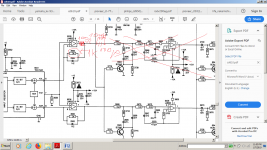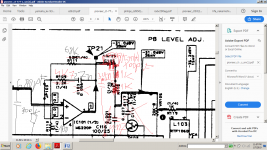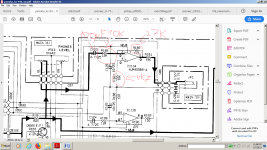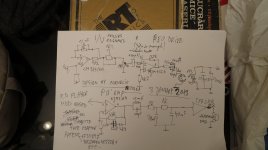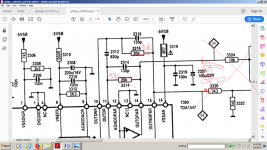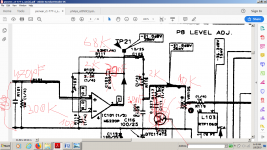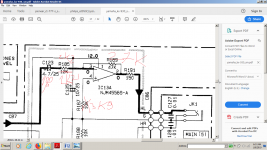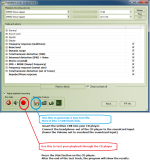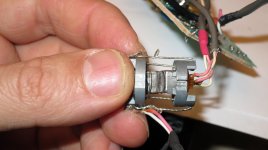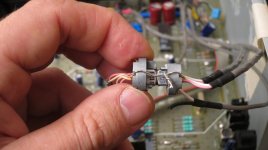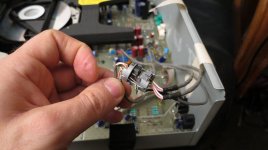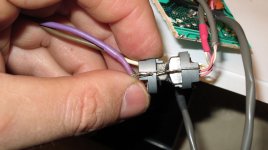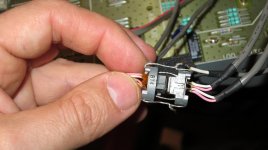First of all i have to tell you that i have a copy-paste similar thread on Tapeheads as most of my ideas came from working on some cassette players this summer and also from some experienced users of that forum. I'm really thankful to Tapeheads community for giving me the wings to explore this type of modding .
It happened that over the Christmas and New year's eve, this year i was completely "home alone" for about 12 days in total...I bought 2 cheap CD players and two cheap double cassette decks (Technics and Sony) from a charity shop.I payed 45 pounds in total for them. As I moved somewhere near London and i barely could get here my own clothes , some basic tools for soldering and a meter i thought that this is an opportunity to make the cheapest mods in the entire history of CD-player modding.
Phillips CD610mk2:
YouTube
YouTube
New headphones amp based on tpa6120, separate power supply supplying the tape heads drive and reproduce preamp(for which i used the original headphones amp section with njm4556-driving the rec head and one njm4580 for reproduce head) and also the I/V converter after the TDA1543 DAC and ultrasonic filter based on ne5532.I had no other op amps or the usual fancy stuff that i have at home but that home is now 2600km away...
The result was really good, but i have a bit of hum due to the use of njm4556 and njm4580 with no regulators for the +-12v power supply that i made for the whole analog section.The extra transformers aren't shieleded either...The schematic of CD610 shows that the analog section is supplied by +-15v, but truth is that it uses +15-5v supply for the op-amps ...I just used two single ended transformers , a rectifier bridge and many electrolytic capacitors everywhere.I could make even this hum completely dissapear but it didn''t bother me at all in this experiment.
The basic idea was to couple the output of the ultrasonic filter to a record tape head from a cassette player , read it with another reproduce head and amplify it for the headphones.The result is simply that it gives the impression of a professional player now.
Phillips CD951
YouTube
YouTube
Second step was to apply the tape-heads coupling technique to the output of i/v section of TDA1547 DAC only through a simple LC filter trap used usually in cassete players to separate the bias stage from the reproduce preamplifier .The value of the parallleled capacitor is critical to the trap filter rejection of the ultrasonic noise.The next stage is the reproduce head amplifier based on one half of the Signetics NE5532 on board...I had no other option.Then straight to it's headphones amp.The headphones amplifier is based also on njm4556(this time this has it's own filter capacitors while in cd610 it had only a decoupling capacitor between + and -supply rail..
I did something that I advise anybody who has a headphone stage based on njm4556.Unleash it's real power by converting it from non-inverting to inverting topology as in Yamaha KX930 cassette player. I kept the 27kohm feedback resistor and placed a 2k35 resistor on the negative input while the non-inverting input is 3k9 to ground.It should be about 1k8 but previously i used 4k7 on the inverting input and 3k9 is about 4k7//27k so i was just lazy and left the 3k9 resistor in place.
There's a small secret about TDA1547 coupled to the record tape head.I changed the transimpedance i/v stage of TDA1547 resistors (20k) with a lower value.I tried 10k in place, then 20k//10k=6k65, but i think that a value of 8k2 or 9k1 would work best with the usual cassette tape heads while still giving a good SNR.This way i have less saturation for the I/V stage(1v rms max output for 10k ) probably more noise , but i can't be more happy than i am with this simple mod.I though first to couple the output of TDA1547 through electrolitic capacitors to the tapehead, but for now i find it ok.The best way would be to use a good op amp for the balanced to unbalanced stage plus one with a pot to give the right signal to the tape head as i used in the other Phillips player. Most probably i will use some njm2114 or ADA4898-2 when i get hold on it again...now i'm on the run.
I dream already of making my Denon dcd1560 the best CD player in the Galaxy.
It happened that over the Christmas and New year's eve, this year i was completely "home alone" for about 12 days in total...I bought 2 cheap CD players and two cheap double cassette decks (Technics and Sony) from a charity shop.I payed 45 pounds in total for them. As I moved somewhere near London and i barely could get here my own clothes , some basic tools for soldering and a meter i thought that this is an opportunity to make the cheapest mods in the entire history of CD-player modding.
Phillips CD610mk2:
YouTube
YouTube
New headphones amp based on tpa6120, separate power supply supplying the tape heads drive and reproduce preamp(for which i used the original headphones amp section with njm4556-driving the rec head and one njm4580 for reproduce head) and also the I/V converter after the TDA1543 DAC and ultrasonic filter based on ne5532.I had no other op amps or the usual fancy stuff that i have at home but that home is now 2600km away...
The result was really good, but i have a bit of hum due to the use of njm4556 and njm4580 with no regulators for the +-12v power supply that i made for the whole analog section.The extra transformers aren't shieleded either...The schematic of CD610 shows that the analog section is supplied by +-15v, but truth is that it uses +15-5v supply for the op-amps ...I just used two single ended transformers , a rectifier bridge and many electrolytic capacitors everywhere.I could make even this hum completely dissapear but it didn''t bother me at all in this experiment.
The basic idea was to couple the output of the ultrasonic filter to a record tape head from a cassette player , read it with another reproduce head and amplify it for the headphones.The result is simply that it gives the impression of a professional player now.
Phillips CD951
YouTube
YouTube
Second step was to apply the tape-heads coupling technique to the output of i/v section of TDA1547 DAC only through a simple LC filter trap used usually in cassete players to separate the bias stage from the reproduce preamplifier .The value of the parallleled capacitor is critical to the trap filter rejection of the ultrasonic noise.The next stage is the reproduce head amplifier based on one half of the Signetics NE5532 on board...I had no other option.Then straight to it's headphones amp.The headphones amplifier is based also on njm4556(this time this has it's own filter capacitors while in cd610 it had only a decoupling capacitor between + and -supply rail..
I did something that I advise anybody who has a headphone stage based on njm4556.Unleash it's real power by converting it from non-inverting to inverting topology as in Yamaha KX930 cassette player. I kept the 27kohm feedback resistor and placed a 2k35 resistor on the negative input while the non-inverting input is 3k9 to ground.It should be about 1k8 but previously i used 4k7 on the inverting input and 3k9 is about 4k7//27k so i was just lazy and left the 3k9 resistor in place.
There's a small secret about TDA1547 coupled to the record tape head.I changed the transimpedance i/v stage of TDA1547 resistors (20k) with a lower value.I tried 10k in place, then 20k//10k=6k65, but i think that a value of 8k2 or 9k1 would work best with the usual cassette tape heads while still giving a good SNR.This way i have less saturation for the I/V stage(1v rms max output for 10k ) probably more noise , but i can't be more happy than i am with this simple mod.I though first to couple the output of TDA1547 through electrolitic capacitors to the tapehead, but for now i find it ok.The best way would be to use a good op amp for the balanced to unbalanced stage plus one with a pot to give the right signal to the tape head as i used in the other Phillips player. Most probably i will use some njm2114 or ADA4898-2 when i get hold on it again...now i'm on the run.
I dream already of making my Denon dcd1560 the best CD player in the Galaxy.
Last edited:
Somebody just told me that there's actually a commercial project that is currently using this idea, but you can't patent the electronic cassette adapter again 
Rupert Neve Designs Portico 5042 "True Tape" Emulation Released - Rupert Neve
Cassette tape adaptor - Wikipedia
Rupert Neve Designs Portico 5042 "True Tape" Emulation Released - Rupert Neve
Cassette tape adaptor - Wikipedia
Last edited:
I turned back to the Phillips CD610 , made the feedback resistor of the i/v stage about 730 ohms(1k//2k7), made the whole rc group series with a 120ohms resistor , grounded the filter stage and canceled it, fed the rec head directly through a 1.2kohm resistor, coupling capacitor and some ferrite filters, the rest left the same.The bass wasn't right.Too many highs.Then, in the second video , you'll see that i reintroduced the njm4556 after the i/v stage to drive the rec head.Bass is ok now. This time i modified the njm4556 amplifier to be inverting topology(3x gain) .Both CD951 and CD610 had a headphones amplifier based on njm4556 in noninverting topology.Here i used the njm4556 to drive the rec head.This way i can use the pot to finely increase the level and the distortion levels produced by the tapehead system, while the njm4556 can easily drive the head with no series resistor if needed, allthough i still have a 150 ohms rez on the output.
YouTube
YouTube
YouTube
YouTube
YouTube
Well...I think that i've been carried away a bit as the bass response isn't great.As i used a njm4556 headphones amp to drive the rec tapehead i could check the sound in it's jack socket and the bass is better before the tapehead coupling system.
Basically , in CD951 it's the tda1547 vout output driving the rec tapehead directly, the playback head is read by a typical cassette playback preamp with no frequency correction(for now, but that is going to change) made with half of the signetics ne5532 on board, then a headphones amp with njm4556 in inverting topology(basically the yamaha kx930 headphones amp)
In cd610 it's the i/v stage based on lm833 driving his original headphones amp based on njm4556 as well in inverting topology(the same yamaha kx930) driving the rec tape head, another stage with the same playback amplifier and the tpa6120 based headphones amplifier.I'll have to reintroduce some frequency correction to cut the highs.I'll make some drawings when i'll get a better bass response .
Well...I think that i've been carried away a bit as the bass response isn't great.As i used a njm4556 headphones amp to drive the rec tapehead i could check the sound in it's jack socket and the bass is better before the tapehead coupling system.
Basically , in CD951 it's the tda1547 vout output driving the rec tapehead directly, the playback head is read by a typical cassette playback preamp with no frequency correction(for now, but that is going to change) made with half of the signetics ne5532 on board, then a headphones amp with njm4556 in inverting topology(basically the yamaha kx930 headphones amp)
In cd610 it's the i/v stage based on lm833 driving his original headphones amp based on njm4556 as well in inverting topology(the same yamaha kx930) driving the rec tape head, another stage with the same playback amplifier and the tpa6120 based headphones amplifier.I'll have to reintroduce some frequency correction to cut the highs.I'll make some drawings when i'll get a better bass response .
Last edited:
I finally got the Bass right by simply building a proper playback preamp.The values i chose for the components were kind of random as i only had three stripped pcb boards as a source for components.By the way i just ruined an Arcam Alpha 8 tuner to have my playback preamp built.This is a combination between the playback preamps of pioneer ct-777 and ct93(filter sections), with a pi filter 1kohm-3.9nF-1k-4.7nF ald an lc trap 15mH//100pF after the preamp.There's also another lc trap before the rec tapehead.I doubt it's really working with the kind of frequencies generated by the CD player but i had no other components at hand.Hi dreamth
Can you make a drawing with your suggested mod and post a pic?
George
Cassette tape adaptor - Wikipedia
US Patent for Cassette adapter for playback device, such as a compact disk player Patent (Patent # 4,734,897 issued March 29, 1988) - Justia Patents Search
YouTube
YouTube
Now i can really enjoy this system.Untill i'll be in the possesion of all the equipment and the components needed to make this design a full proof one i simply enjoy music.
Attachments
Last edited:
The sound is good enough in both of my players for my ears, i just needed to remove the 3.9 nf capacitor from the pi filter after the playback preamp wuth njm2114, but it could be better with regulated power supplies ,properly calculated and measured stages, shielding(the tape preamp is picking some of the internal noises in cd player plus i need to properly reject the ultrasonic frequencies before the REC head if i really want the best results.I'm 2600 km away of my lab, having only basic soldering equipment and a multimeter...I only bought 2 CD players, one tuner and two mini-systems(technics-sony) to source the components...Maybe in 6 months from now, I'll be having the opportunity to use a proper lab again...
Of course...all the other usual mods can be applied for the best player.I am absolutely sure that you don't need more than a cd player and well mastered cd's to really enjoy music .I'm a vinyl addict as some of my threads clearly suggests, but my encounter with a Pioneer cassette deck last summer changed many of my old perceptions on audio and it wasn't even the best cassette player out there!
I need to do one more mod, add a dolby c encode decode process in the system.Allthough there's no tape here, i've seen that some of the best dolby c systems on tape can make miracles with the sound, but i can't describe the feeling.I need to know if it's the tape or the dolby c system that really does it.
I simply have no job for now and this Christmas i seized the right moment to give a reality to some of my thoughts..It couldn't be a better gift for Christmas although it came a little bit later
Of course...all the other usual mods can be applied for the best player.I am absolutely sure that you don't need more than a cd player and well mastered cd's to really enjoy music .I'm a vinyl addict as some of my threads clearly suggests, but my encounter with a Pioneer cassette deck last summer changed many of my old perceptions on audio and it wasn't even the best cassette player out there!
I need to do one more mod, add a dolby c encode decode process in the system.Allthough there's no tape here, i've seen that some of the best dolby c systems on tape can make miracles with the sound, but i can't describe the feeling.I need to know if it's the tape or the dolby c system that really does it.
I simply have no job for now and this Christmas i seized the right moment to give a reality to some of my thoughts..It couldn't be a better gift for Christmas although it came a little bit later
Last edited:
It couldn't be a better gift for Christmas although it came a little bit later
Hi dreamth
A gift is a gift, whenever it comes.
Maybe in 6 months from now, I'll be having the opportunity to use a proper lab again...
For to run a freq response test (or a full test suite) you do not need lab equipment. A laptop with a cd recorder and an internal soundcard is what is needed.
Download and install the free RMAA
Latest News. Audio Rightmark
Do a test run with the CD player modified.
If you want to compare, do another test run with the CD player unmodified.
I need to know if it's the tape or the dolby c system that really does it.
I bet it’s the tape but do your own tests.
George
Attachments
Not sure about that...i'm not a sound recording engineer...but Neve applied this technique in one of their current products:Couldn't you do the same with a parametric equalizer ?
Rupert Neve Designs Portico 5042 "True Tape" Emulation Released - Rupert Neve
Actually I know why i did it this way!
Coils and transformers have magnetic saturation cores.Tape cassette heads are the cheapest to source saturable cores reactors working up to very high frequencies. Of course, the saturation applies only to the RECORD , or drive head in this system, but you can run an important dc current through the Playback head too. They are made from perm-alloy and other special magnetic materials that allows to be easily saturated by very low currents.
There was a specific Patent that caught my attention as it justify completely why analog simulations of tube amplifiers are not easy and not everybody really understood the basic phenomenon explained by it:
Semiconductor amplifier with tube amplifier characteristics - PRITCHARD; ERIC K.
The only thing missing here is a true valve driving the REC tape-head, but i thought also to drive it in single ended with a j-fet or depletion mos-fet in the deep sub-threshold bias area maybe with reel to reel tape heads
and ...that's all for today folks!
Last edited:
Once you've used Audio Precision equipment you start to become a little bit pickyFor to run a freq response test (or a full test suite) you do not need lab equipment. A laptop with a cd recorder and an internal soundcard is what is needed.
Download and install the free RMAA
Latest News. Audio Rightmark
Do a test run with the CD player modified.
If you want to compare, do another test run with the CD player unmodified.
I bet it’s the tape but do your own tests.
George
There's not even a chance to use a laptop for this now and all the spare time i had for these toys finished.
Undoubtedly , the tape has it's own merits, but the encoding decoding process in dolby c is a very aggressive process and it surely has it's own touch on the sound too.
Last edited:
Dreamth
I guess you understand that what your mod does to the sound is either a low pass filter effect or a compression due to tape head saturation or most probably both of them.
For to test the low pass filter effect, a frequency response test at a single signal level will suffice.
For to test the head saturation, you have to use a few test signals each at different level and test for freq envelope and harmonics generation.
You may wait for getting back to your AP for all these tests, it’s up to you.
Meanwhile, enjoy listening to your CDs.
Thanks for posting your modifications.
George
I guess you understand that what your mod does to the sound is either a low pass filter effect or a compression due to tape head saturation or most probably both of them.
For to test the low pass filter effect, a frequency response test at a single signal level will suffice.
For to test the head saturation, you have to use a few test signals each at different level and test for freq envelope and harmonics generation.
You may wait for getting back to your AP for all these tests, it’s up to you.
Meanwhile, enjoy listening to your CDs.
Thanks for posting your modifications.
George
I really do!Dreamth
Meanwhile, enjoy listening to your CDs.
George
I needed to ask a mate to help me with re-gluing the tape heads in the CD951 as the first time the gluing was less than optimal.It still is, but better than the first time...CD951 is also a bit noisier because of its ground proximity to the digital ground and digital components, while in the CD610 I have a completely different power supply and the components are far from the digital board itself. For now i just managed to take out all the hum and digital noises in the cd610. I have better coupling in CD951 and i realize that i need to lower even more the output of tda1547.
Attachments
Last edited:
harmonics generation.
This plus some noise is perhaps key for the subjective improvements.
There used to be a similarly way out attempt, if i recall correctly of French origin, to use an inverse riaa module at a cd player output and then play through a phono stage.
And yes, i do recall people preferring to listen to a tape recording rather than the cd.
A good reminder how horrible digital used to be 30 years ago.
This plus some noise is perhaps key for the subjective improvements.
There used to be a similarly way out attempt, if i recall correctly of French origin, to use an inverse riaa module at a cd player output and then play through a phono stage.
And yes, i do recall people preferring to listen to a tape recording rather than the cd.
A good reminder how horrible digital used to be 30 years ago.
All the CD-players would output 2v rms because of the better SNR the op-amps used in I/V stage can achieve.
Most of the power amplifier on the market work best with less that 1v.
That means that anything that follows the I/V stage needs to work in UNITY GAIN!
No op-amp likes unity gain.Filters need to be more agressive at these levels, their output impedance become significant for the usual loads.
Allmost no op amp can beat ne5532, njm2068, njm2114, m5220, upc4570 if given a significant gain.
There's no significant quality to be achieved over 80...84db of SNR so you don't even need 16 bits .
GIVE A DAMN GAIN TO YOUR OP AMPS!
So you made a (mild) effect box?
Although you're technically correct, I wouldn't say that because you can't perceive the distortions generated by it as "effecting" the sound.If you listen to a Harman Kardon amp with 1% distortions , or a good valve amplifier with 5% distortions , you don't necessarily have the feeling that it is distorting the sound and make it worse than another amplifier with 0.003% distortions...actually most of the listeners would say otherwise, that these "effects" are the most "transparent" and that they give a sublime "rich "sound, "silky highs"...etc, etc...
You just have the feeling that you're listening to good music with some of these effects!
Few people walked into a recording studio to see how many effects are used with any single voice or instrument in the recording process...Imagine that every single mike or instrument will get first into a limiter compressor that gives you 0.5% distortions at best and that is just the first link in a chain that usually have harmonizers, valve compressors, at least 10 op-amps in a recording and mixing line, adc, dac, etc...Not to mention that miking an electrocal guitar is done through picking up the sound of an actual speaker with a microphone...
The electric guitar you're listening too on your overly linear system is using a pick-up magnetic cartridge with at least 1% distortion added by itself...and you like that sound! The CLEAN Fender valve amplifier used by your favourite artist is generating 5...10% distortions...
Am i entitled to say that my "effect" is actually very clean compared wuth the rest of the recording chain?What if i don't like at all the recording itself , how it was mastered ?
If I'm willingly affecting the musical content of my albums, that is because
I'm too legit to quit
- Status
- This old topic is closed. If you want to reopen this topic, contact a moderator using the "Report Post" button.
- Home
- Source & Line
- Digital Source
- Best way to mod cheap cd-players-enhancing the noise
